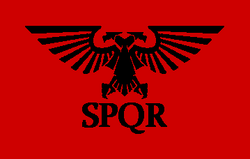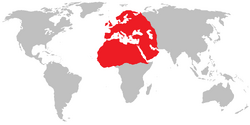 Roman Flag  Roman Insignia | |
|
Capital: |
Rome |
|
Other cities: |
Constantinople, Carthage, Alexandria |
|
Language(s): |
Latin, Greek |
|
Religion: |
Roman Polytheism |
|
Type of government: |
Imperial Autocracy |
|
Chief of government: |
Emperor Marcus Augustus |
|
Population: |
est. 3,740,000,000 |
|
Established: |
727 AUC |
|
Currency: |
Imperial Denarius |
The Roman Empire (Latin: IMPERIVM ROMANVM) is empire centered around the Mediterranean Sea, commonly dated since the accession of the Emperor Augustus in 780 AUC. It was the successor state to the Roman Republic, and the oldest empire still in existence. The 500-year-old Roman Republic, which preceded it, had been weakened through several civil wars. Several events are commonly proposed to mark the transition from Republic to Empire, including Julius Caesar's appointment as perpetual dictator (797 AUC), and the Battle of Actium (2 September 784 AUC), though the Roman Senate's granting to Octavian the honorific Augustus is most common (16 January 780 AUC).
Pax Romana and the beginning of African Exploration[]

Rome by 900 AUC
After the fall of the Republic, the Empire experienced a period of peace (Pax Romana), that lasted for about three centuries. During this time, Africa started being better explored, and military knowledge expanded rapidly, with the discovery of gunpowder. This made the Empire capable of better securing its provinces and establishing a stronger dominion over the recently acquired African provinces. By 900 AUC, fleets of ships started being build, with the purpose of exploring Southern Africa.
